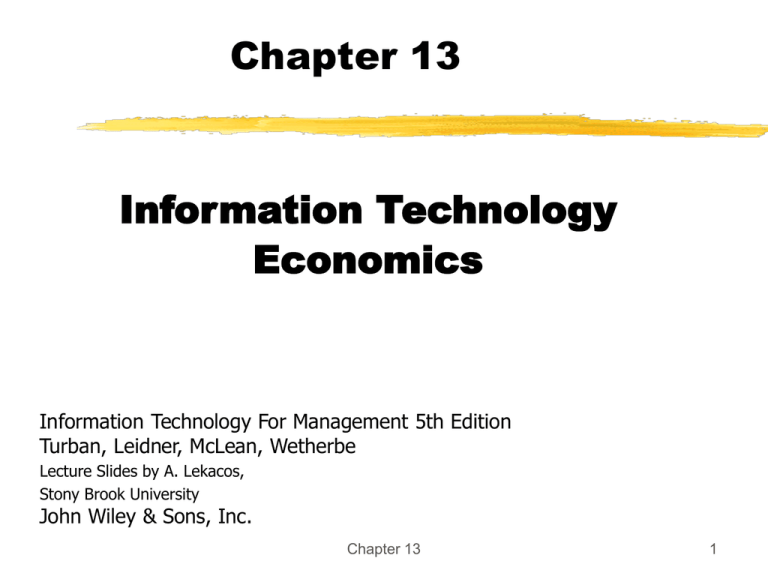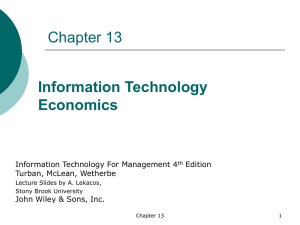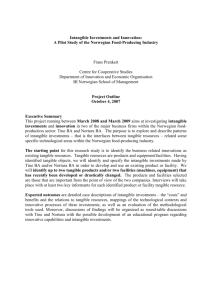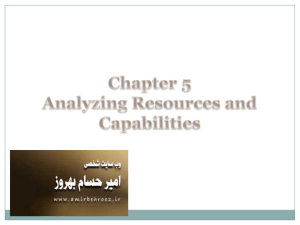
Chapter 13
Information Technology
Economics
Information Technology For Management 5th Edition
Turban, Leidner, McLean, Wetherbe
Lecture Slides by A. Lekacos,
Stony Brook University
John Wiley & Sons, Inc.
Chapter 13
1
Learning Objectives
•
•
•
•
•
•
•
•
•
•
Identify the major aspects of the economics of information technology.
Explain and evaluate the productivity paradox.”
Describe approaches for evaluating IT investment and explain why is it difficult
to do it.
Explain the nature of intangible benefits and the approaches to deal with it.
List and briefly describe the traditional and modern methods of justifying IT
investment.
Identify the advantages and disadvantages of approaches to charging end
users for IT services (chargeback).
Identify the advantages and disadvantages of outsourcing.
Describe the economic impact of EC.
Describe economic issues related to Web-based technologies including ecommerce.
Describe causes of systems development failures, the theory of increasing
returns, and market transformation through new technologies.
Chapter 13
2
Computing Power vs. Benefits
What does growth in computing power mean in economic terms? First,
most organizations will perform existing functions at decreasing costs
over time and thus become more efficient. Second, creative organizations
will find new uses for information technology—based on the improving
price-to-performance ratio and thus become more effective.
What is the payoff from IT investments?
How can it be measured?
• Evaluate
• the productivity
• the benefits
• the costs
• other economic aspects of information technology
Chapter 13
3
Moore’s Law
Chapter 13
4
Productivity - One measure
Productivity is a ratio than measures outputs versus inputs. It is calculated
by dividing outputs by inputs. On a company by company basis major
benefits from information technology investments have been shown.
However, it is very hard to demonstrate, at the level of a national economy,
that the IT investments really have increased outputs or decreased inputs.
The discrepancy between measures of investment in information
technology and measures of output at the national level has been called
the productivity paradox.
•
Possible explanations of the paradox
1. problems with data or analyses hide productivity gains from IT
2. gains from IT are offset by losses in other areas
3. IT productivity gains are offset by IT costs or losses.
Chapter 13
5
Benefits and Costs
- Other measures
Distinguishing between investments in infrastructure and investments in
specific applications will assist the analysis. IT infrastructure, provides the
foundations for IT applications in the enterprise (data center, networks, date
warehouse, and knowledge base) and are long-term investments shared by
many applications throughout the enterprise. IT applications, are specific
systems and programs for achieving certain (payroll, inventory control, order
taking) objectives and can be shared by several departments, which makes
evaluation of their costs and benefits complex.
•
Evaluating IT Investments
•
Value of Information in Decision Making
•
Traditional Cost-Benefit Analysis (tangibles)
•
Scoring Matrix or Scorecard (intangibles)
Chapter 13
6
Value of Information
- evaluating
One measurement of the benefit of an investment is the value of the
information provided. The value of information is the difference between the
net benefits (benefits adjusted for costs) of decisions made using information
and the net benefits of decisions made without information.
Value of information = Net benefits with information - Net benefits without information
It is generally assumed that systems that provide
relevant information to support decision making will
result in better decisions, and therefore they will
contribute toward the return on investment. However,
this may not always be the case.
Chapter 13
7
Cost-Benefits Analyses
- evaluating
Capital investment decisions can also be analyzed by cost-benefit
analyses, which compare the total value of the benefits with the associated
costs. Traditional tools used to evaluate capital investment decisions are
net present value and return on investment.
•
In Net present value (NPV) calculations analysts convert future
values of benefits to their present-value equivalent by discounting
them at the organization’s cost of funds. They then compare the
present value of the future benefits to the cost required to achieve
those benefits.
•
Return on investment (ROI) measures the effectiveness of
management in generating profits with its available assets (the
higher the better). It is calculated by dividing net income attributable
to a project by the average assets invested in the project.
Chapter 13
8
Cost-Benefits Analyses
Chapter 13
- evaluating
9
“Costing” IT Investments
Placing a dollar value on the cost of IT investments is not a simple
task. One of the major issues is to allocate fixed costs among different
IT projects. Fixed costs are those costs that remain the same in total
regardless of change in the activity level.
Another area of concern is the Life Cycle Cost; costs for keeping it
running, dealing with bugs, and for improving and changing the
system. Such costs can accumulate over many years, and sometimes
they are not even anticipated when the investment is made.
There are multiple kinds of values (tangible and intangible)
- evaluating
improved efficiency
improved customer relations
the return of a capital investment measured in dollars or percentage
many more …
Probability of obtaining a return depends on probability of
implementation success
Chapter 13
10
Intangible Benefits-evaluating
IT projects generate intangible benefits such as increased quality, faster
product development, greater design flexibility, better customer service, or
improved working conditions for employees. These are very desirable
benefits, but it is difficult to quantify them with a monetary value.
Intangible benefits can be very complex and substantial.
•
Evaluating Intangible Benefits
•
Make rough estimates of monetary values for all intangible
benefits, and then conduct a NVP or similar financial analysis.
•
Scoring Matrix or Scorecard
Chapter 13
11
Intangible Benefits
Sawhney’s Method of Handling
Think broadly and softly.
Supplement hard financial metrics with soft ones
Pay your freight first.
Think carefully about short-term benefits that can “pay the
freight” for the initial investment in the project.
Follow the unanticipated.
Keep an open mind about where the payoff from IT and ebusiness projects may come from
Chapter 13
12
Business Case Approach
- evaluating
One method used to justify investments in projects is referred to as the
business case approach. A business case is a written document used by
managers to garner funding for specific applications or projects. Its major
emphasis is the justification for the required investment. It also provides
the bridge between the initial plan and its execution by incorporating the
foundation for tactical decision making and technology risk management.
•
The business case helps:
•
to clarify how the organization will use its resources
•
justifying the investment
•
to manage the risk
•
determine the fit of an IT project with the organization’s mission
Chapter 13
13
Investment Justification
Chapter 13
- evaluating
14
Evaluating and Justifying IT Investment
IT investment pose different problems from traditional capital investment
decisions. However, even though the relationship between intangible IT
benefits and performance is not clear, some investments should be better
than others.
• Appraisal methods are categorized into the following four types.
• Financial (NPV & ROI) methods consider only impacts that can be monetary-valued.
They focus on incoming and outgoing cash flows.
• Multicriteria (Information economics and Value analysis) appraisal methods consider
both financial impacts and non-financial impacts that cannot be expressed in
monetary terms. These methods employ quantitative and qualitative decisionmaking techniques.
• Ratio (IT expenditures vs. total turnover) methods use several ratios to assist in IT
investment evaluation.
• Portfolio methods apply portfolios (or grids) to plot several investment proposals
against decision-making criteria.
Chapter 13
15
Specific Evaluation Methods
The following evaluation methods that are particularly useful in
evaluating IT investments.
• Total cost of ownership (TCO is a formula for calculating the cost of
owning, operating, and controlling an IT system. The cost includes:
• acquisition cost (hardware and software)
• operations cost (maintenance, training, operations, …)
• control cost (standardization, security, central services)
• Value analysis method evaluates intangible benefits on a low-cost, trial
basis before deciding whether to commit to a larger investment in a
complete system.
Chapter 13
16
Specific Evaluation Methods
-
continued
• Information economics is an approach that focuses on key
organizational objectives, including intangible benefits. Information
economics incorporates the familiar technique of scoring
methodologies, which are used in many evaluation situations.
• A scoring methodology evaluates alternatives by assigning weights
and scores to various aspects and then calculating the weighted
totals. The analyst
1.identifies all the key performance issues
2.assigns a weight to each one
3.Each alternative in the evaluation receives a score on each factor,
usually between zero and 100 points, or between zero and 10.
4.These scores are multiplied by the weighting factors and then totaled.
The alternative with the highest score is judged the best.
Chapter 13
17
Specific Evaluation Methods
-
continued
It is much more difficult to evaluate infrastructure investment decisions
than investments in specific IS application projects. Since many of the
infrastructure benefits are intangible and are applicable to different present
and future applications.
• Two methods:
• Benchmarks - objective measures of performance. These measures are often
available from trade associations or annual statement analyses.
• Metric benchmarks provide numeric measures of performance, for example:
•
•
•
•
IT expenses as percent of total revenues
percent of downtime (time when the computer is unavailable)
CPU usage as a percentage of total capacity
percentage of IS projects completed on time and within budget.
• Best-practice benchmarks emphasis is on how information system activities are
actually performed rather than on numeric measures of performance.
Management by Maxim - brings together corporate executives, business-unit managers,
and IT executives in planning sessions to determine appropriate infrastructure
investments for the corporation.
Chapter 13
18
Specific Evaluation Methods
-
continued
Management by Maxim
Chapter 13
19
Specific Evaluation Methods
-
continued
A new approach for evaluating IT investments is to recognize that they can
increase an organization’s performance in the future.
Instead of using only traditional measures like NPV to make capital
decisions, financial managers look for opportunities that may be embedded
in capital projects. These opportunities, if taken, will enable the
organization to alter future cash flows in a way that will increase
profitability. These opportunities are called real options.
• Common types of real options include:
• the option to expand a project (so as to capture additional cash flows from
such growth)
• the option to terminate a project that is doing poorly (in order to minimize
loss on the project)
• the option to accelerate or delay a project.
Real Option Valuation of IT Investment
Chapter 13
20
Specific Evaluation Methods
-
continued
• The balanced scorecard method evaluates the overall health of organizations
and projects. It advocates that managers focus not only on short-term
financial results, but also on four other areas:
1. finance, including both short- and long-term measures
2. customers (how customers view the organization)
3. internal business processes (finding areas in which to excel)
4. learning and growth (the ability to change and expand)
• Activity-based costing (ABC) views the value chain and assigns costs and
benefits based on the activities.
• Expected value (EV) of possible future benefits by multiplying the size of the
benefit by the probability of its occurrence.
Chapter 13
21
Specific Evaluation Methods
Chapter 13
-
continued
22
“Costing” IT – Economic Strategies
In addition to identifying and evaluating the benefits of IT, firms need to
account (track) for its costs. Accounting systems should provide an accurate
measure of total IT costs for management control. Second, users should be
charged for shared IT investments and services in a manner that is
consistent with the achievement of organizational goals.
•
Two strategies for costing of IT services:
•
Chargeback
1. All expenses go into an overhead account. With this approach IT is “free” and has no
explicit cost, so there are no incentives to control usage or avoid waste.
2. Cost recovery is an approach where all IT costs are allocated to users as accurately as
possible, based on actual costs and usage levels.
3. Behavior-oriented chargeback system sets IT service costs in a way that meets
organizational objectives, even though the charges may not correspond to actual costs.
•
Outsourcing
•
strategy for obtaining the economic benefits of IT and controlling its costs by obtaining
IT services from outside vendors rather than from internal IS units within the
organization.
Chapter 13
23
“Costing” IT – Economic Strategies
•
Outsourcing - continued
• Offshore outsourcing of software development
• ASPs and Utility Computing. Application service provider (ASP) manages and distributes
software-based services and solutions from a central, off-site data center, via the Internet.
• Management service provider (MSP) is a vendor that remotely manages and monitors
enterprise applications.
Chapter 13
24
Web-based Systems
– Economic Strategies
Web-based systems can considerably increase productivity and profitability.
However, the justification of EC applications can be difficult. Usually one
needs to prepare a business case that develops the baseline of desired
results, against which actual performance can and should be measured. The
business case should also cover both the financial and non-financial
performance metrics against which to measure the e-business
implementation and success.
Most decisions to invest in Web-based systems are based on the
assumption that the investments are needed for strategic
reasons and that the expected returns cannot be measured in
monetary values.
Chapter 13
25
Failures
Information technology is difficult to manage and can be costly when things
do not go as planned. A high proportion of IS development projects either
fail completely or fail to meet some of the original targets for features,
development time, or cost. Many of these are related to economic issues,
such as an incorrect cost-benefit analysis.
The economics of software production suggest that, for
relatively standardized systems, purchasing or leasing can
result in both cost savings and increased functionality.
Purchasing or leasing can also be the safest strategy for very
large and complex systems.
Irrespective of the potential for failure IT has the potential to
completely transform the economics of an industry.
Chapter 13
26
MANAGERIAL ISSUES
• Constant growth and change. The power of the microprocessor chip doubles every two
years, while the cost remains constant. This ever-increasing power creates both major opportunities
and large threats as its impacts ripple across almost every aspect of the organization and its
environment. Managers need to continuously monitor developments in this area to identify new
technologies relevant to their organizations, and to keep themselves up-to-date on their potential
impacts.
• Shift from tangible to intangible benefits. Few opportunities remain for automation
projects that simply replace manual labor with IT on a one-for-one basis. The economic justification
of IT applications will increasingly depend on intangible benefits, such as increased quality or better
customer service. In contrast to calculating cost savings, it is much more difficult to accurately
estimate the value of intangible benefits prior to the actual implementation. Managers need to
understand and use tools that bring intangible benefits into the decision-making processes for IT
investments.
• Not a sure thing. Although IT offers opportunities for significant improvements in organizational
performance, these benefits are not automatic. Managers need to very actively plan and control
implementations to increase the return on their IT investments.
Chapter 13
27
MANAGERIAL ISSUES Continued
• Chargeback. Users have little incentive to control IT costs if they do not have to pay for them
at all. On the other hand, an accounting system may allocate costs fairly accurately to users but
discourage exploration of promising new technologies. The solution is to have a chargeback
system that has the primary objective of encouraging user behaviors that correspond to
organizational objectives.
• Risk. Investments in IT are inherently more risky than investments in other areas. Managers
need to evaluate the level of risk before committing to IT projects. The general level of
management involvement as well as specific management techniques and tools need to be
appropriate for the risk of individual projects.
• Outsourcing. The complexities of managing IT, and the inherent risks, may require more
management skills than some organizations possess. If this is the case, the organization may
want to outsource some or all of its IT functions. However, if it does outsource, the organization
needs to make sure that the terms of the outsourcing contract are in its best interests both
immediately and throughout the duration of the agreement.
• Increasing returns. Industries whose primary focus is IT, or that include large amounts of IT
in their products, often operate under a paradigm of increasing returns. In contrast, industries
that primarily produce physical outputs are subject to diminishing returns. Managers need to
understand which paradigm applies to the products for which they are responsible and apply
management strategies that are most appropriate.
Chapter 13
28
Chapter 13
Copyright © 2005 John Wiley & Sons, Inc. All rights
reserved. Reproduction or translation of this work
beyond that permitted in Section 117 of the 1976
United States Copyright Act without the express
written permission of the copyright owner is
unlawful. Request for further information should be
addressed to the Permissions Department, John
Wiley & Sons, Inc. The purchaser may make backup copies for his/her own use only and not for
distribution or resale. The Publisher assumes no
responsibility for errors, omissions, or damages,
caused by the use of these programs or from the
use of the information contained herein.
Chapter 13
29







